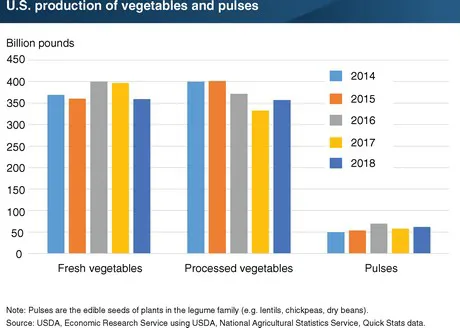Consumer demand for fresh vegetables in the US remains high, but domestic fresh vegetable production fell 10 percent from 2017 to 2018, marking the largest year-to-year decline of the last 20 years (1999–2018). Furthermore, for the same 20-year period, 2018 domestic fresh vegetable production reached its lowest level at 359 billion pounds, largely the result of diminishing harvested area.
The production decline from 2017 to 2018 coincided with a drop in both area harvested and yields of most fresh-market vegetables—partially driven by above-average heat during the growing season. In contrast, production of processed vegetables grew by over 7 percent in from 2017 to 2018. The increase was almost entirely due to a 17-percent increase in tomato production, which made up 75 percent of processed vegetable volume in the United States.
Divergent trends in the latest year’s production of fresh and processed vegetables can be partially explained by differing states and crop mixes, and each represent a return to approximately 4-year ago levels. Although pulse production is much smaller on a volume basis, production growth relative to 2017 was equally strong. Driven mainly by increases in chickpea production, production of pulses (e.g., chickpeas, lentils, and dry beans) grew by nearly 7 percent from 2017 to 2018.

This chart appears in the ERS Vegetables and Pulses Outlook newsletter, released in May 2019.
